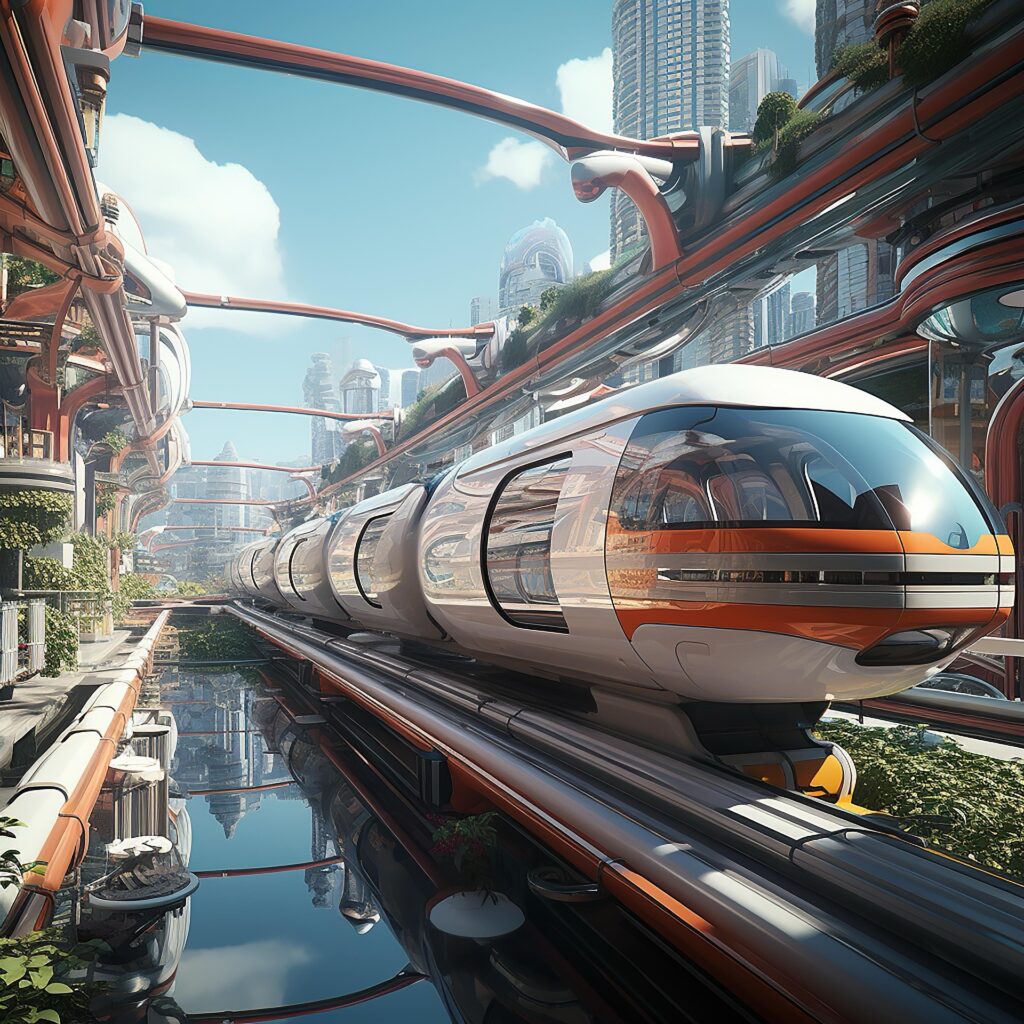
Introduction:
Imagine traversing vast distances at near supersonic speeds whisked away in sleek pods gliding through vacuum tubes. This isn’t science fiction it’s the vision of a Hyperloop and a revolutionary transportation concept that promises to redefine and structure in how we travel. The Hyperloop proposes is a high speed ground transport system for both passengers and freight for offering the potential for faster and safer also more efficient travel compared to existing options. While still in its developmental stages, the Hyperloop has captured the imagination of engineers and investors also the public alike and sparking a global race to bring this ambitious idea to reality. This article will delve into the core principles of the Hyperloop. And its potential benefits are the technological hurdles it faces, and the progress being made towards its realization.
Read also: The future of virtual reality
1. The Core Concept:
Vacuum and Magnetic LevitationAt its heart the Hyperloop operates on two key principles are reducing air resistance and minimizing friction. Traditional high speed trains face the significant drag at elevated speeds limiting their efficiency and maximum velocity. The Hyperloopaddresses this by the encasing its passenger or cargo pods within a near vacuum tube and with most of the air removed the pods encounter significantly less resistance and allowing them to travel at much higher speeds with less energy expenditure.
To further enhance efficiency and smoothness many Hyperloopdesigns incorporate magnetic levitation technology. Instead of relying on wheels and tracks and maglev uses powerful magnets to levitate the pods above the guide way eliminating friction. This combination of a low-pressure environment and frictionless movement is what enables the Hyperloop to theoretically achieve speeds exceeding 700 miles per hour.
2. Potential Advantages:
Speed, Efficiency, and Sustainability The realization of a functional Hyperloop network could be bring about a multitude of benefits. The most obvious is the drastic reduction in travel time. Journeys that are currently take hours by car or train could be completed in a fraction of the time for potentially transforming commuting the patterns and the facilitating greater connectivity between distant cities.
Beyond speed the Hyperloop also holds promise for increased energy efficiency. By minimizing air resistance and friction that the system requires less energy to propel its pods compared to the conventional transportation methods at similar speeds. Many and many proponents envision of the Hyperloop being powered by renewable energy sources that are contributing to a more and more sustainable transportation future with reduced carbon emissions.
3. Technological Challenges:
Vacuum, Propulsion, and Safety Despite its alluring potential the development of aviable Hyperloop system are faces significant technological hurdles and Maintaining a near perfect vacuum over vast distances requires robust. And reliable tube infrastructure. Any leaks or breaches could compromise the system efficiency and safety.Propelling the pods within the low pressure environment also presents a well challenge. While initial concepts proposed linear induction motors various propulsion methods are being explored including air compressors and are magnetic propulsion systems. Ensuring smooth acceleration and deceleration at the high speeds is crucial for passenger comfort and more safety.
Safety is paramount in any transportation system and the Hyperloop is no exception for them. Designing a system that can operate safely at such high speeds and handle potential emergencies also ensure passenger well being within the enclosed tubes requires meticulous engineering and rigorous testing.
4. Global Race:
Companies and Projects Worldwide The Hyperloop vision has ignited a global race and with several companies also research institutions actively pursuing its development. Virgin Hyperloop are for instance that has conducted successful human trials of its technology. Mostly other companies like Hyperloop Transportation Technologies and Trans Pod are also making strides in research and development. Focusing on different aspects of the technology and exploring potential routes across the globe.
Various feasibility studies and preliminary projects are underway in countries like the United States, Canada, India, and the United Arab Emirates, assessing the economic and the technical viability of Hyperloop corridors are opened. While no fully operational commercial Hyperloop exists yet and the progress being made in testing and also development suggests that the technology is gradually moving closer to reality.
5. Economic Implications:
Investment and Job Creation The development and deployment of a Hyperloop network would be represent a massive infrastructure and undertaking with significant economic implications. The initial investment costs are expected to be substantial and encompassing research and development also land acquisition, tube construction, and the manufacturing of pods and supporting infrastructure.
Proponents argue that the long term economic benefits could outweigh these initial costs. The creation of new industries that are manufacturing jobs and operational roles associated with the Hyperloop could stimulate economic growth. The increased efficiency in freight transport and the enhanced connectivity for businesses could lead to greater productivity and the trade.
6. Environmental Considerations:
Land Use and Noise PollutionWhile the Hyperloop aims for sustainability are through energy efficiency and the renewable power sources are environmental considerations regarding land use and potential noise pollution need careful evaluation. Constructing long stretches of elevated or underground tubes could impact existing ecosystems and the require significant land acquisition.
Mitigating potential noise generated by the movement of pods especially in densely populated areas and will also be crucial. Careful route planning and noise dampening technologies also environmental impact assessments will be necessary to ensure the Hyperloop integration with the environment is as seamless as possible.
7. The Passenger Experience:
Comfort and Convenience The success of the Hyperloop will ultimately depend on the passenger experience. Designing comfortable and spacious pods and ensuring smooth acceleration and deceleration also providing a seamless boarding and disembarking process are essential. Addressing potential concerns about traveling at high speeds within enclosed tubes will also be important for the public acceptance.
Integrating the Hyperloop with existing transportation networks and providing convenient access to stations, and offering competitive pricing will be key factors in attracting passengers and making it a viable alternative to current travel options.
8. The Future Outlook:
Integration and Evolution The Hyperloop is not intended to replace all existing forms of transportation but rather to complement them and particularly for long distance travel. Integrating Hyperloop networks with airports and train stations also urban transit systems will be the crucial for creating a comprehensive and the efficient transportation ecosystem.
As the technology matures we can expect the further evolution and innovation in Hyperloop design and materials also operational efficiency. The future may see the development of specialized pods for freight transport, the integration of autonomous technologies and also the expansion of Hyperloopnetworks connecting major cities and regions across the globe.
Conclusion:
The Hyperloop represents a bold and ambitious vision for the future of transportation. While significant technological, economic and regulatory hurdles remain and the potential benefits of ultra high speed travel increased efficiency and sustainability are compelling. The ongoing research, development, and global interest in the Hyperloop suggest that this revolutionary concept is steadily progressing from the realm of science fiction towards a tangible reality. As the world is continues to seek faster more efficient and environmentally conscious ways to connect people and goods also the Hyperloopstands as a promising contender in shaping the future of mobility.
Buy Now
Quantum Computing for Computer Scientists

